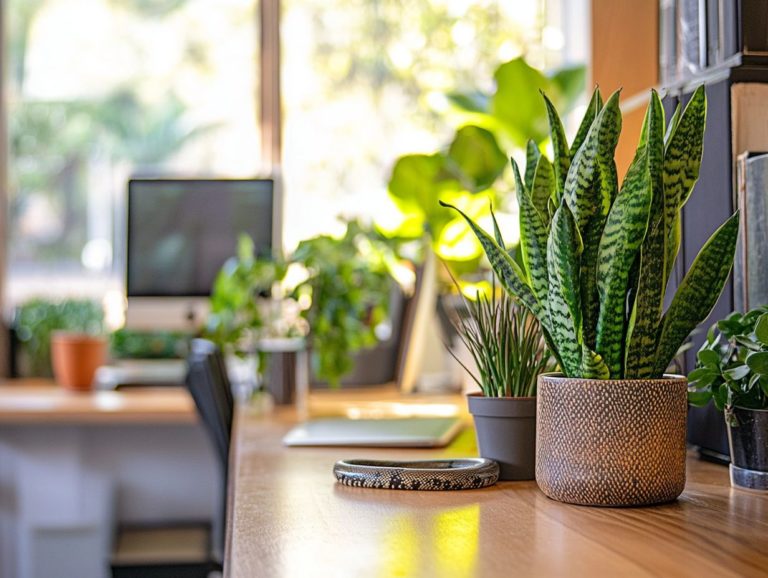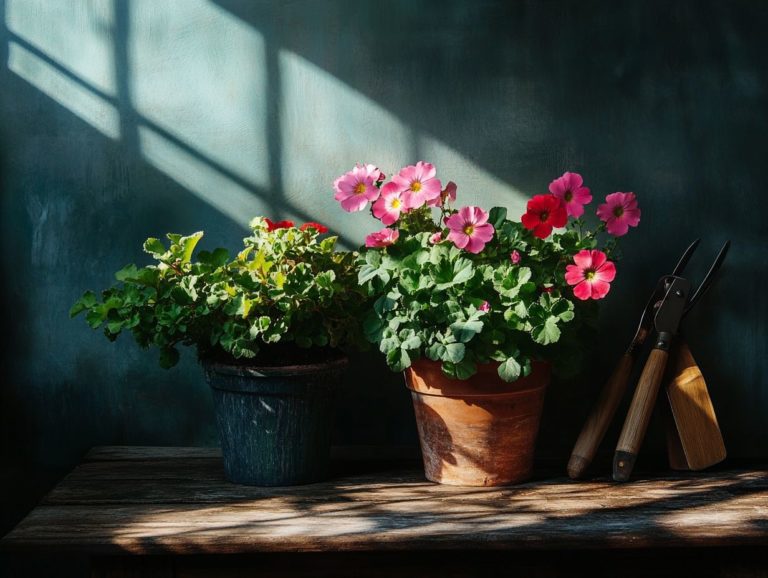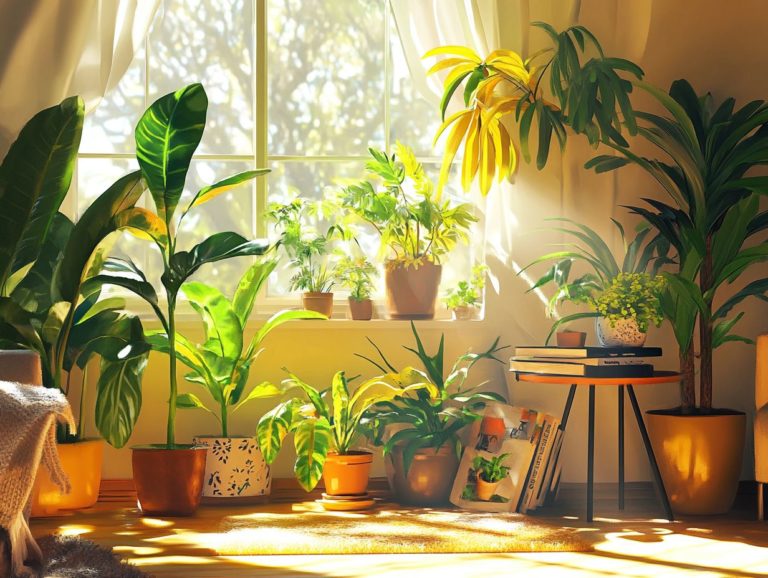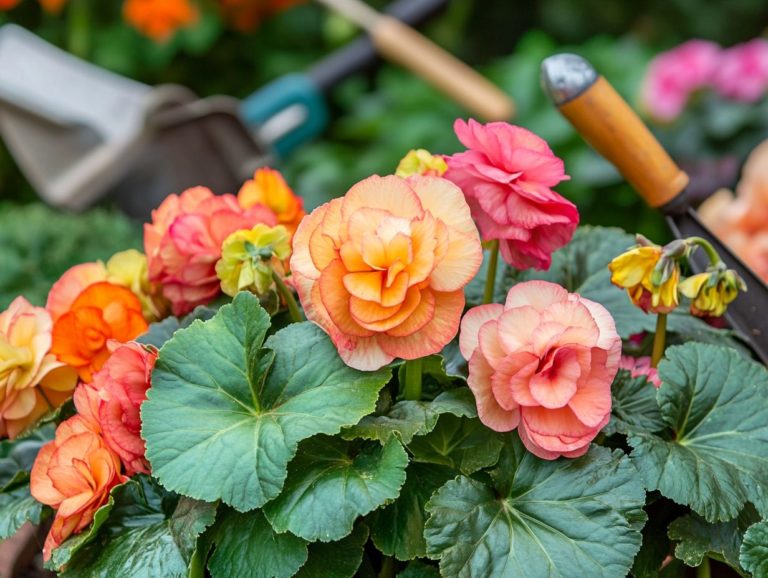Top 5 Indoor Orchid Types for Homes
Orchids captivate with their stunning beauty and unique charm. They are a highly sought-after choice for indoor plants.
This guide delves into the top five types of orchids that flourish indoors: Phalaenopsis, Cattleya, Dendrobium, Oncidium, and Paphiopedilum.
Beyond their aesthetic appeal, this guide provides essential care insights. It covers everything from light and temperature preferences to watering techniques and common pests.
Whether you re an experienced plant enthusiast or just starting your journey, this information will empower you to successfully cultivate these exquisite blooms in your home.
Contents
- Key Takeaways:
- 1. Phalaenopsis Orchids
- 2. Cattleya Orchids
- 3. Dendrobium Orchids
- 4. Oncidium Orchids
- 5. Paphiopedilum Orchids
- What Are the Basic Care Requirements for Indoor Orchids?
- How Much Light Do Orchids Need Indoors?
- What Is the Ideal Temperature for Indoor Orchids?
- How Often Should Orchids Be Watered and Fertilized?
- What Are the Common Pests and Diseases That Affect Indoor Orchids?
- How Can One Propagate Indoor Orchids?
- Ready to transform your home with stunning orchids? Let’s explore the best ways to display them!
- How Can One Extend the Blooming Period of Indoor Orchids?
- What Are the Different Types of Potting Mediums for Indoor Orchids?
- What Are the Benefits of Having Indoor Orchids in the Home?
- Can Indoor Orchids Be Kept in Bathrooms?
- How Can One Create the Ideal Humidity for Indoor Orchids?
- Frequently Asked Questions
Key Takeaways:
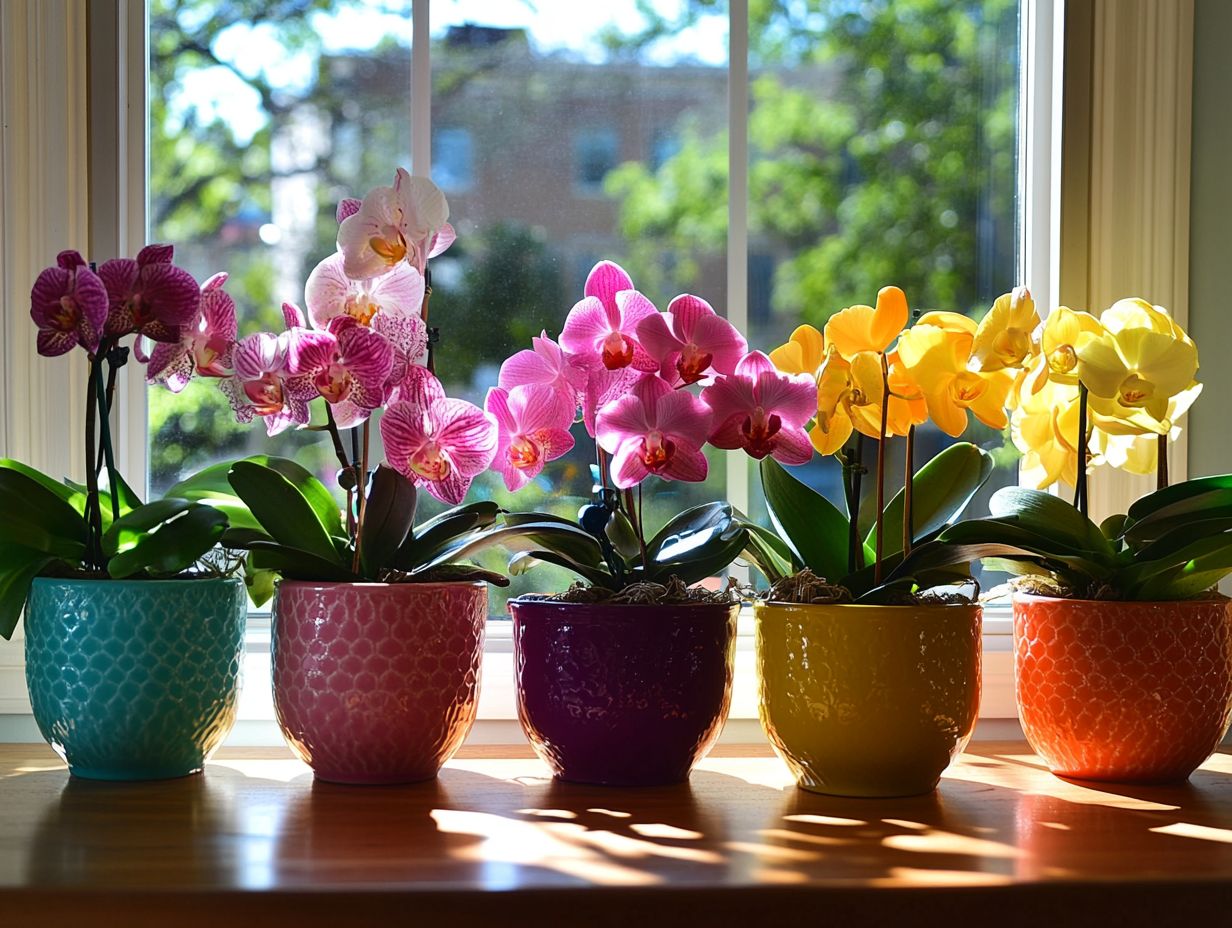
- Phalaenopsis, Cattleya, Dendrobium, Oncidium, and Paphiopedilum are the top 5 types of indoor orchids for homes.
- Indoor orchids require proper care regarding light, temperature, watering, fertilizing, and protection from pests and diseases.
- Indoor orchids can be propagated, displayed, and kept in bathrooms with the right techniques and care.
1. Phalaenopsis Orchids
Phalaenopsis orchids, often called moth orchids, are some of the most exquisite houseplants. They enchant indoor gardening enthusiasts with their breathtaking blooms in a range of elegant colors and patterns. They are a beloved choice for both collectors and casual gardeners alike.
These low-maintenance wonders are celebrated for their ability to flourish indoors. They add a lovely touch to any room. Their long-lasting flowers can quickly become the centerpiece of your houseplant collection, earning admiration from flower lovers and gardening experts worldwide.
What truly distinguishes these orchids is their preference for bright, indirect light and forgiving nature regarding humidity and temperature variations. Ideal temperatures hover between 65 F to 80 F with well-draining potting media, which is a type of soil that allows water to flow through easily, preventing root rot. You ll find that they are surprisingly resilient, with myriad hybrid varieties boasting diverse colors and patterns.
Keeping these beautiful plants thriving will bring joy to your home. Proper watering and occasional fertilization with balanced orchid food are essential. Regular inspections for pests will help keep your Phalaenopsis orchids healthy.
2. Cattleya Orchids
Cattleya orchids are renowned for their vibrant colors and delightful fragrance. They are a coveted addition to any indoor plant collection. If you re an orchid enthusiast, you ll appreciate their unique beauty and charm.
These stunning blooms come in a rich tapestry of shades ranging from deep purples to bright yellows and crisp whites, captivating anyone lucky enough to encounter them. To ensure these beauties thrive, they love bright, indirect light and warm temperatures between 65 F and 80 F conditions that mimic their natural tropical habitats.
Watering should be done weekly, but you might want to adjust that based on the humidity of your environment. With countless species and hybrids available, each showcasing distinctive petal shapes and sizes, it s no surprise they often steal the spotlight in interior spaces, dramatically enhancing the ambiance.
3. Dendrobium Orchids
Dendrobium orchids are a captivating group of exotic plants that come in a stunning array of colors and forms. Each adds a unique charm to your indoor gardening space. These orchids, with their specific care needs, can truly elevate your indoor garden to new heights.
Some varieties showcase dramatic cascading blooms, while others offer compact, bushy foliage. They appeal to both novice plant enthusiasts and seasoned gardeners. To ensure they flourish, provide them with bright, indirect sunlight and maintain temperatures between 65 and 85 F during the day, allowing for cooler nights to encourage blooming.
It’s essential to keep humidity levels consistent, ideally between 40-60%. Use a well-draining potting medium to help maintain moisture. Regular watering during the growing season, while allowing the roots to dry out between sessions, will help keep these mesmerizing plants healthy and thriving.
4. Oncidium Orchids
Oncidium orchids, often called dancing lady orchids, are a true delight with their charming, intricate flowers that can elevate the ambiance of any indoor space. They are relatively low maintenance, making them perfect for both novice and seasoned gardeners alike.
To ensure these captivating blooms thrive, provide them with bright, indirect sunlight, which mimics their natural habitat beneath tree canopies. Water them only when the top inch of the soil feels dry, and be mindful of drainage to prevent root rot.
Within this enchanting group, you’ll find species like Oncidium Gower Ramsey and Oncidium Sharry Baby. Each showcases unique traits such as varying colors and delightful scents that are sure to captivate any observer. To maximize blooming, maintain moderate humidity and fertilize with a balanced orchid mix every couple of weeks during the growing season. This simple step can spark vibrant growth and stunning displays of flowers.
5. Paphiopedilum Orchids
Paphiopedilum orchids, commonly referred to as lady slipper orchids, are truly celebrated for their unique and captivating flowers. They make a stunning addition to your indoor gardening collection, infusing it with an exotic flair.
These enchanting plants feature a distinctive flower structure that resembles a delicate slipper, effortlessly drawing the attention of both novice growers and seasoned collectors. Give these beauties the care they crave: a humid environment, well-draining potting media (this means a type of soil that allows water to flow through easily), and filtered light.
Aim for temperatures between 65 F and 75 F, as this range allows these orchids to thrive and showcase their full potential. Regular watering is crucial, but make sure to let the medium dry slightly between sessions. This approach fosters healthy growth and contributes to a vibrant display that will captivate anyone who encounters them.
What Are the Basic Care Requirements for Indoor Orchids?
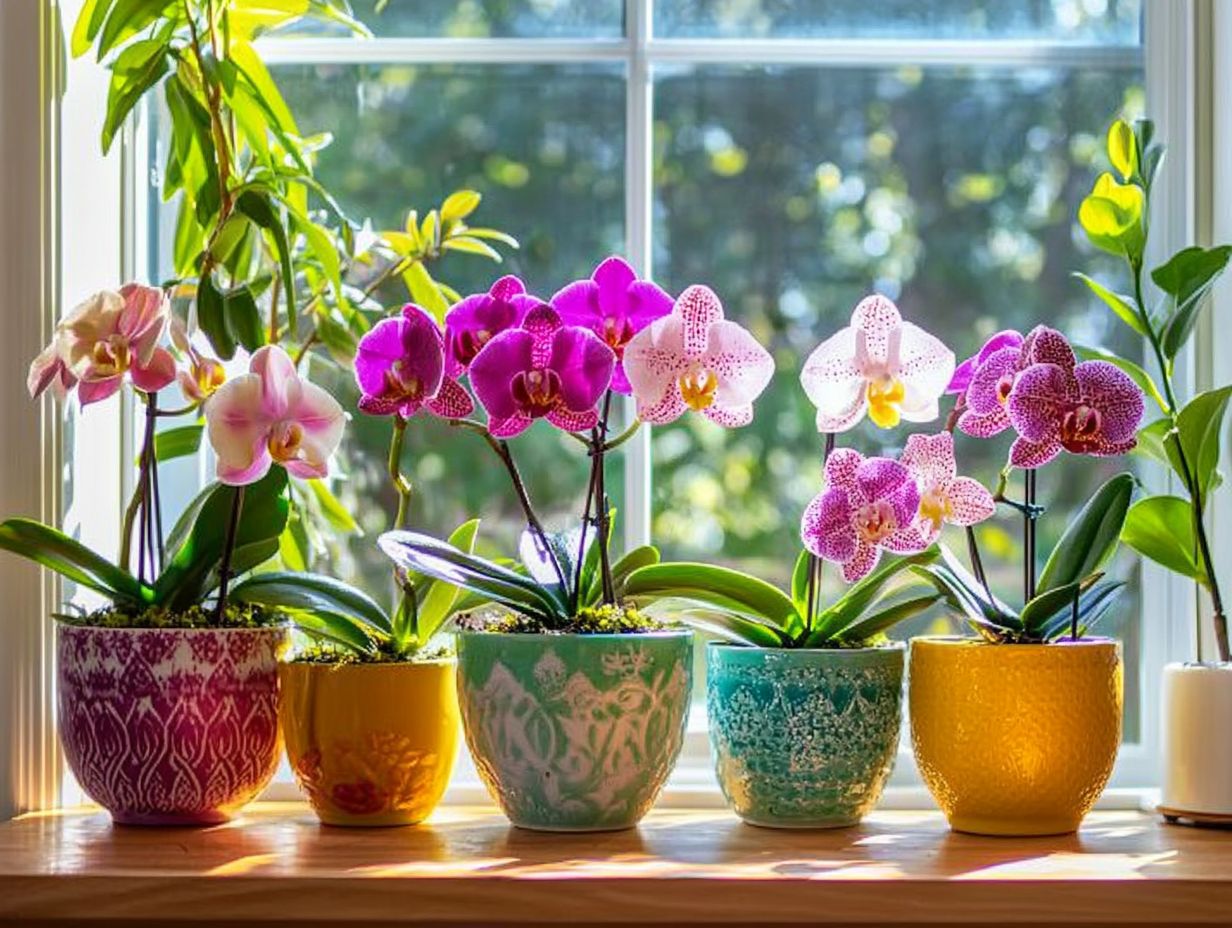
Caring for indoor orchids means diving deep into their specific needs light, temperature, humidity, and watering. With the right environment, you can help these stunning plants thrive and delight you with beautiful blooms all year round.
Each species of orchid has its own care requirements. For instance, Phalaenopsis orchids thrive in moderate, indirect sunlight, while Dendrobium varieties tend to prefer brighter light. Temperature plays a pivotal role; most orchids enjoy a cozy range between 65 F and 75 F during the day, with slightly cooler nights to keep them happy.
Maintaining humidity levels of around 50-70% will make them feel right at home. Watering should take place when the top inch of the potting medium feels dry, usually every one to two weeks. To keep your orchids growing beautifully, consider applying a balanced fertilizer every couple of months. Opt for a well-draining potting mix, like bark or sphagnum moss, to ensure the roots are aerated and avoid the dreaded stagnant water.
How Much Light Do Orchids Need Indoors?
Understanding the light requirements for your orchids is essential for achieving success in indoor gardening. Different species flourish under various light conditions, ranging from bright, indirect light to more subdued environments.
For instance, Phalaenopsis orchids thrive in bright, filtered sunlight, making an east-facing window an ideal spot. They can even handle a bit of direct morning sunlight. On the other hand, Cattleya orchids crave more intense light and typically do well with western exposure, relishing several hours of direct sunlight each day.
Dendrobium varieties also prefer bright conditions but can adapt to slightly shadier spots if needed. To ensure each type receives the optimal amount of light, consider rotating them occasionally for even exposure. Keep a close eye on their leaves: yellowing may signal too much sunlight, while dark green leaves could suggest they’re not getting enough.
What Is the Ideal Temperature for Indoor Orchids?
The ideal temperature for your indoor orchids can vary among species. It s crucial to maintain a consistent range between 60 F and 80 F to ensure their health and encourage blooming.
For example, Phalaenopsis orchids thrive in warmer conditions, often preferring temperatures closer to the upper end of this range. In contrast, Cattleya orchids are a bit more adaptable. They tolerate slightly cooler nights while enjoying warmer daytime temperatures. Dendrobium species appreciate a nighttime temperature drop that mimics their natural habitat.
To cultivate the perfect indoor environment for your orchids, use a thermostat to regulate the temperature. Place your orchids away from drafty windows or heating vents. Good air circulation is essential. Using grow lights can help maintain stable temperature levels, especially during colder months. Additionally, considering the top 5 tropical plants for indoor environments can further enhance your space and ensure that all species receive optimal conditions for robust growth.
How Often Should Orchids Be Watered and Fertilized?
Proper watering and fertilizing are essential for your orchid-care. The frequency should be tailored to the specific species and environmental conditions to ensure your delicate plants receive the nutrients they need to flourish.
To establish an effective watering schedule, consider the particular species of orchid and the humidity levels in their environment. Some orchids may thrive with weekly watering, while others might require a more or less frequent approach.
Observing the roots offers valuable insights; healthy roots are generally green and firm. In contrast, brown, mushy roots can indicate overwatering. If you notice shriveling leaves, it might be time to increase your watering efforts.
In addition to watering, adopting the right fertilizing schedule typically a balanced orchid fertilizer every two to four weeks during the growing season can significantly promote robust growth and vibrant blooms. Ensure your stunning plants reach their full potential.
What Are the Common Pests and Diseases That Affect Indoor Orchids?
Indoor orchids are typically resilient, but they can fall prey to various pests and diseases. Stay alert! Your orchids depend on your watchful eye against potential threats.
You might encounter common pests like aphids and mealybugs, which feast on the delicate leaves and stems of your orchids. Diseases such as root rot can stealthily undermine the plant s health. Regularly check for signs of damage or discoloration and ensure good air circulation is maintained.
Implement preventative measures like avoiding overwatering and using a sterile potting mix to diminish the risk of root rot. Introducing beneficial insects can be a game-changer in battling aphid infestations. Early detection enables you to explore timely treatment options like insecticidal soap or organic remedies to keep your orchids thriving beautifully.
How Can One Propagate Indoor Orchids?
Propagating indoor orchids is a rewarding journey that enables you to expand your collection. You can employ techniques like division, small offshoots or ‘baby’ orchids (keikis), and seed propagation to replicate these stunning plants, each offering unique benefits tailored to different orchid types.
For instance, dividing a mature plant into smaller sections encourages healthier growth and more vibrant blooms. Creating keikis is an exciting and straightforward method that requires minimal intervention. While seed propagation is more intricate and time-consuming, it can lead to a delightful array of new varieties.
To ensure a successful propagation adventure, grasp the specific requirements of each technique, such as optimal timing and the right environmental conditions. Embrace the nuances of each method, and you ll find your orchid collection flourishing beautifully.
Ready to transform your home with stunning orchids? Let’s explore the best ways to display them!

Displaying indoor orchids with flair can truly elevate their breathtaking beauty, transforming your home into a stunning focal point that combines beauty and functionality for optimal growth.
By thoughtfully selecting decorative pots that harmonize with your existing decor, you can enhance the ambiance of any room. Arranging these exquisite plants in groups can inject depth and intrigue, turning an ordinary corner into a vibrant botanical showcase.
Consider light and humidity when placing your orchids; this not only showcases their beauty but also supports their growth. Orchids thrive in bright, indirect sunlight and enjoy a humid environment.
How Can One Extend the Blooming Period of Indoor Orchids?
Unlock the secrets to extending the blooming period of your indoor orchids with proper care! This includes adequate light, temperature control, and regular fertilization. These elements allow your stunning orchids to showcase their unique flowers for a longer time.
To achieve this, place your orchids in a spot where they can bask in bright, indirect sunlight for at least six hours each day. Just be careful too much direct sun can scorch those lovely leaves.
Regularly adjust the temperature to keep it ideal, aiming for 65 F to 80 F during the day and slightly cooler at night. This mimics the natural conditions of their native habitat perfectly.
Using a balanced liquid fertilizer every two weeks during the growing season ensures your orchids receive the necessary nutrients for robust growth and an extended blooming cycle. Maintain humidity levels around 50-70% for best results. You might consider using a humidity tray or misting the leaves to create an environment that encourages beautiful flowering.
What Are the Different Types of Potting Mediums for Indoor Orchids?
Choosing the right potting medium for your indoor orchids is crucial for their health. Different types of media provide varying levels of drainage, aeration, and moisture retention, each tailored to specific orchid species.
For example, pine bark is a favorite among orchid enthusiasts. It offers excellent drainage and a lightweight structure, making it ideal for epiphytic orchids, or orchids that grow on other plants, like Phalaenopsis. On the flip side, sphagnum moss is renowned for its moisture retention capabilities. However, it requires careful monitoring to avoid overwatering, making it better for orchids that thrive in consistently humid conditions, such as the Paphiopedilum. If you’re also considering houseplants for your space, check out the top 5 indoor plants for east-facing windows to enhance your indoor garden.
Consider incorporating perlite to enhance aeration and drainage when mixed with other media. This combination can significantly promote healthy root growth. Selecting the right medium not only meets your orchid s specific needs but also plays a vital role in its overall growth and blooming potential.
What Are the Benefits of Having Indoor Orchids in the Home?
Don’t miss out on the wealth of benefits that indoor orchids can bring to your home! From elevating the aesthetic appeal with their stunning blooms to enhancing air quality, they cultivate a serene atmosphere in your living space.
These captivating plants are not just eye-catching focal points but also significantly enhance mental well-being. Their vibrant colors and intricate forms can uplift your mood and spark creativity, making them a cherished choice for gardening enthusiasts.
Orchids typically require minimal care, making them perfect for anyone without extensive gardening know-how. Their resilience offers a gratifying sense of accomplishment as they flourish with just a touch of your attention.
The joy of nurturing these elegant flowers deepens your connection to nature, creating a tranquil environment that promotes relaxation and fosters a greater appreciation for the beauty surrounding you.
Can Indoor Orchids Be Kept in Bathrooms?
Indoor orchids can truly flourish in your bathroom, as long as you keep a close eye on the environmental conditions like humidity and light. This will provide these exquisite plants with the care they deserve.
The naturally high humidity in bathrooms creates a perfect climate for these delicate blooms, fostering optimal growth and vibrant flowering. To fully leverage this moisture, it’s essential to ensure your orchids receive plenty of indirect light. Most varieties thrive in bright yet filtered sunlight. Additionally, if you’re considering other indoor options, check out the top 5 shade-tolerant indoor plants. Positioning them near frosted windows or using sheer curtains will help soften the light and prevent any harsh exposure.
Species like Phalaenopsis and Paphiopedilum are particularly well-suited for bathroom environments. They relish the warmth and moisture to yield stunning, long-lasting flowers. For those looking to brighten up their spaces, exploring the top 5 indoor plants for bright spaces can be a great option.
How Can One Create the Ideal Humidity for Indoor Orchids?
Creating the right humidity for your indoor orchids is vital for their health and vitality. Most species flourish in environments with humidity levels between 40% and 70%, which closely mimic their native tropical habitats.
To achieve these conditions, consider using humidifiers. They effectively raise moisture levels evenly throughout the air. Placing pebble trays filled with water beneath your pots can also enhance local humidity, giving the surrounding area an extra boost.
Grouping your orchids together can create a mini-ecosystem. This allows them to share moisture through transpiration, which works wonders for their well-being.
Keep a close eye on humidity levels with a hygrometer. Low humidity can lead to stress, stunted growth, or reduced flower production. Ensuring optimal humidity is truly the key to helping your orchids thrive.
Watch this video to learn more about caring for indoor orchids!
Frequently Asked Questions
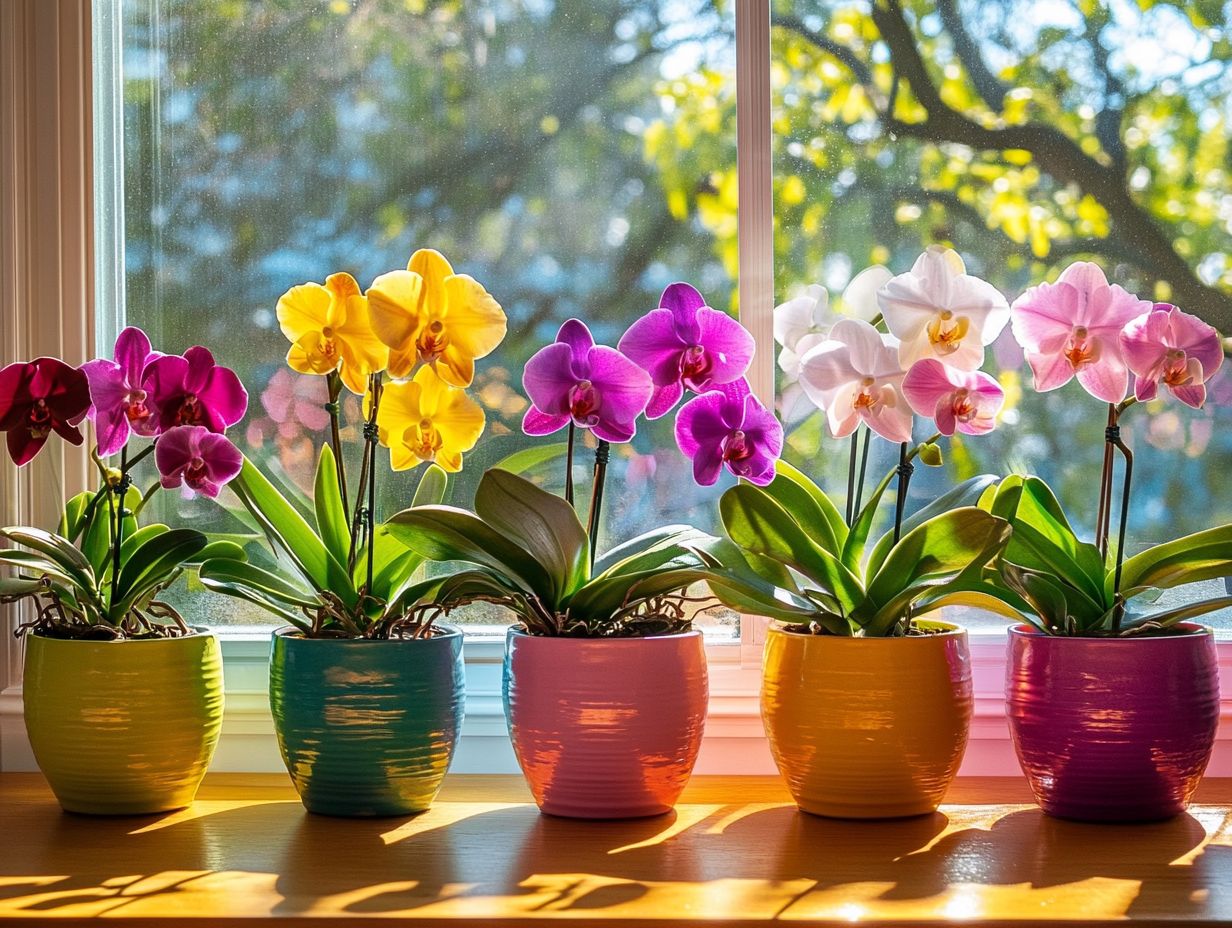
What are the top 5 indoor orchid types for homes?
The top 5 indoor orchid types for homes are Phalaenopsis, Dendrobium, Cattleya, Cymbidium, Oncidium, and Paphiopedilum. These beautiful houseplants are popular choices among gardening enthusiasts.
What is the most popular indoor orchid type for homes?
The most popular indoor orchid type for homes is the Phalaenopsis, also known as the “moth orchid.” These stunning orchids are known for their unique flowers and charming appearance, making them a favorite among indoor plant collectors.
Are these orchid types easy to care for?
Yes, these orchid types are relatively easy to care for. They require indirect light, moderate watering, and well-draining soil, making them a low-maintenance choice for houseplant enthusiasts. Growing these orchids can be a rewarding gardening experience.
Can these orchids be grown in any type of home?
Yes, these orchids can be grown in any type of home as long as they have the proper lighting, temperature, and humidity levels. Factors such as hardiness zones may also play a role in their thriving, ensuring that they find the right environment.
Start your indoor orchid journey today!
Do these orchids bloom all year round?
No, these orchids have a blooming season that typically lasts a few months. With proper care, they can dazzle you by blooming multiple times a year.
Are these orchids safe for pets?
Yes, these orchids are safe for pets and won’t harm them. Always keep plants out of your pets’ reach to prevent any mishaps.


